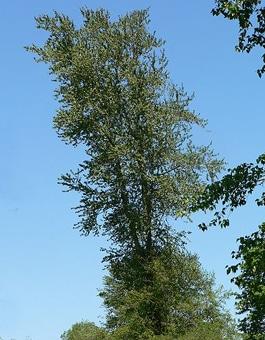

A well-read species
The black cottonwood’s lightweight and strong for its weight, so it is used for plywood and high-quality book and magazine paper. Native Americans used the bark for treating all kinds of ailments, such as wounds and rheumatism. Today we know that the bark contains salicin, which is very similar in structure to aspirin.
Range
It is restricted to stream and river courses throughout Oregon’s valley floors and foothills, where it can grow as extensive stands. It is particularly well suited to well-drained, gravelly soils near streams and tolerant of flooding. It has a low drought tolerance.
Character
The black cottonwood is a fast-growing, large broadleaf tree that can grow up to 200 feet tall and more than 8 feet in diameter. It is the tallest broadleaf tree in western North America. The bark is gray with tenticels, and leaves are glossy dark green on top and light green on the undersides. Although fast-growing, this sun-loving tree does not have a long life span, with trees rarely living more than 100 years.
Climate
Black cottonwood prefers moist, riparian areas at elevations of 0-6,000 feet. It grows best in full sunlight.
Understory
The leaves and shoots are highly prized as food for many wildlife species, including deer, elk and beaver. Large birds often use the tree fortheir nesting sites.
Management
It is best to manage these trees to keep the possibility of fire aslow as possible, as any fire will kill their seeds. A very fast-growing hybrid of black cottonwood and eastern cottonwood is grown in plantations in Oregon for pulp, lumber and biomass.